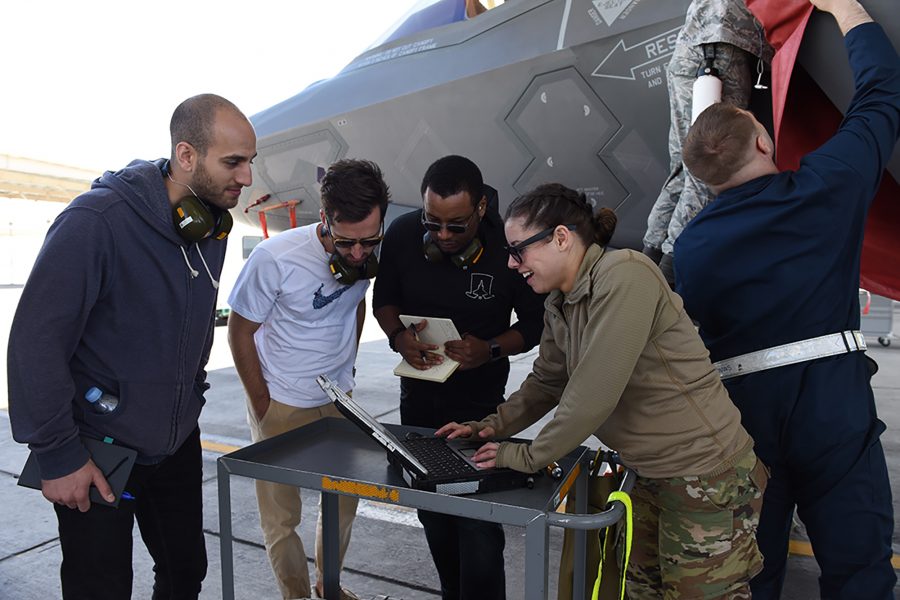The F-35’s troubled Autonomic Logistics Information System has somewhat improved over the past five years, but still causes significant challenges for the Joint Strike Fighter enterprise every day, according to a new Government Accountability Office report published March 16.
The F-35 program office hopes that designing totally new hardware and software will solve the premiere fighter program’s woes. It is slated to send a plan to the Pentagon’s top acquisition official by the end of March for developing the system that will replace the faulty logistics system. A new Operational Data Integrated Network (ODIN) will start to replace ALIS by the end of the year under that plan. Officials hope ditching the problem-ridden software for a totally new set of tools will be smaller, faster, less expensive, and compatible with older data.
“Users at all five locations [studied by the GAO] stated that data processing, downloading of information, and screen navigation were generally faster than previous years,” the federal watchdog wrote. “In previous releases of ALIS, it could take several minutes to complete a simple function like a screen download. … Users also reported minor functionality improvements within certain ALIS applications, such as the Computerized Maintenance Management System, leading to reduced time required to perform actions within those applications.”
ALIS is supposed to help track the F-35’s health, schedule maintenance, order new parts, plan missions, and track training. People can now access data and generate reports that were previously off-limits, and software upgrades rolled out starting in 2015 to fix minor defects have helped improve ALIS.
But concerns remain, including:
- ALIS sometimes says that an aircraft should not fly, even though it shows no signs that it should be grounded, leaving military leaders to make the call about whether to fly.
- Deploying ALIS is challenging because its hardware is bulky, Internet connectivity is limited, and the system requires contractor support.
- It takes more people to support ALIS than F-35 squadrons originally thought.
- Current training doesn’t properly prepare people to use ALIS.
“Users at all five of the locations we visited told us that electronic records are frequently incorrect, corrupt, or missing, resulting in ALIS signaling that the aircraft should be grounded, often in cases where maintainers know that the parts have been correctly installed and are safe for flight,” GAO said. “Users at one location said that within a six-month period in 2019, they experienced anywhere between zero and 400 issues per week related to inaccurate or missing electronic records.”
One commander said that in a wartime scenario, his squadron would assume the risk posed by ALIS missing or incorrectly showing data and fly anyway.
The Pentagon’s preliminary estimate projected ALIS would cost about $17 billion, but GAO said the F-35 program office could not provide how much money has been spent on the system over the years. The report noted that three initiatives aimed at redesigning the system cost more than $73 million as of fiscal 2019.
DOD agrees with GAO’s recommendations that Pentagon acquisition boss Ellen Lord and F-35 Program Executive Officer Lt. Gen. Eric Fick should establish a process for measuring, collecting, and tracking data on how ALIS affects the F-35 fleet’s performance and mission-capable rates across the Air Force, Navy, and Marine Corps variants, which sat around 70 percent as of last September. The Pentagon also agrees that the ODIN development strategy should be detailed enough to have a clear vision of its goals, costs, and possible pitfalls. Lockheed Martin aims to roll out ODIN’s software updates, which are rapidly deployable, more user-friendly, and offer real-time monitoring of the F-35 enterprise, incrementally. It could be fully operational by December 2022.
“The department is building the strategy that will guide ODIN’s development and will include items such as key tasks, milestones and schedule, risks and opportunities, governance structure, and cost estimates,” Lord wrote in a Feb. 23 letter to the GAO. “The F-35 program executive office will deliver this strategy for approval by the under secretary of defense for acquisition and sustainment in first quarter calendar year 2020.”
A Pentagon spokesman did not answer questions on the strategy’s status by press time March 16.
Another set of documents that dictates the capabilities ODIN must offer should also be done early this calendar year.
“The department is committed to developing a top-level capability needs statement and user agreement that will serve as the baseline for the new F-35 [ODIN],” Lord wrote. “These documents will frame the user-defined capabilities and explicit performance requirements and provide flexibility to adapt and modernize the system over time. This will support an ODIN system that has sufficient data granularity and fidelity to enable the collection and tracking of data on how issues are affecting the F-35 fleet.”
GAO worries that without a proper strategy in place, DOD’s transition from ALIS to ODIN over more than 400 aircraft worldwide will be even bumpier.
“With the worldwide fleet expected to grow to over 1,000 aircraft over the next four years, and with the U.S. services becoming increasingly reliant on the F-35’s capabilities to support their operational strategies, it will be imperative for DOD to address the ongoing issues related to the F-35’s logistics system,” GAO said.
The federal watchdog also suggested that Congress take up legislation that would force DOD to have a way to measure ALIS’s performance that judges its actual behavior against what was expected, and to tie that performance to military user requirements.
GAO pointed out that more than five years after it recommended DOD measure those metrics to define how ALIS should be performing, the Pentagon still hasn’t followed through.
“ALIS users collectively agree that the issues with ALIS are affecting the readiness of the aircraft; however, the degree to which this is true remains unknown,” GAO wrote. “Fleet-wide mission-capability rates for the F-35 are still below the warfighter’s minimum targets, but DOD does not have a process for measuring, collecting, and tracking information on how ALIS is affecting these rates. Without such a process, DOD may not understand all of the factors behind the reduced aircraft performance, thus limiting its ability to target appropriate solutions.”


